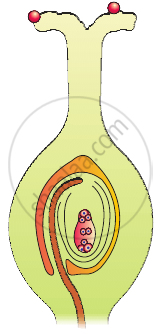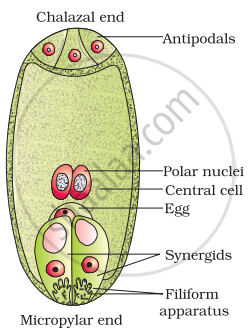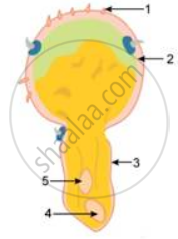Advertisements
Advertisements
Question
In the diagram given below, show the path of a pollen tube from the pollen on the stigma into the embryo sac. Name the components of egg apparatus.

Solution
Following compatible pollination, the pollen grain germinates on the stigma to produce a pollen tube through one of the germ pores. The contents of the pollen grain (2 mole nuclei) move into the pollen tube. Pollen tube grows through the tissues of the stigma and reaches the ovary. After reaching the ovary, pollen tube, enters the ovule through the micropyle and then enters the embryo sac by passing into one of the synergids through the filiform apparatus. It leads to the degeneration of that synergid.
The pollen tube breaks to release its contents (2 male nuclel). Out of the two male gametes one fuses with egg and the other fuses with central cell and fertilise.

Longitudinal section of a flower showing growth of pollen tube
The component cells of the egg-apparatus in an embryo sac include, two synergids one egg cell and the filiform apparatus.

A diagrammatic representation of the mature embryo sac
APPEARS IN
RELATED QUESTIONS
Explain the events up to double fertilisation after the pollen tube enters one of the synergids in an ovule of an angiosperm.
Give one word/term for the following:
When pollen grains of a flower reach the stigma of the same flower.
What happens to the following after fertilization?
Ovules
What are the advantages of the following in the flower to the plant concerned?
Fragrant nectar
Given ahead is a diagrammatic sketch of the sectional view of a germinating pollen grain. Study the same and then answer the question that follows:

What happens to the part labelled '5' during the process?
What is ‘double fertilization’? Describe it with the help of a neat and well-labeled diagram. Give its importance.
Expand the following abbreviation IW.
Identify the incorrect pair
Name the cell which divides to form male nuclei.
In double fertilization, the first male gamete fuses with the egg and the second male gan1ete fuses with which of the following?
The success of seed plants on land is mainly due to ______.
In angiosperms, for formation of which of the following triple fusion is necessary?
In a breeding experiment, the selected male parent is diploid and the female parent is tetraploid. What will be the ploidy level of the endosperm that will develop after double fertilisation?
Double fertilization was first discovered by Nawaschin (1898) in ______.
Double fertilization and triple fusion were discovered by ______.
Fusion of one of the male gametes with egg nucleus is referred to as ______.
The total number of nuclei involved in double fertilisation in angiospersm are ______.
What is the function of the two male gametes produced by each pollen grain in angiosperms?
What is Siphonogamy?
